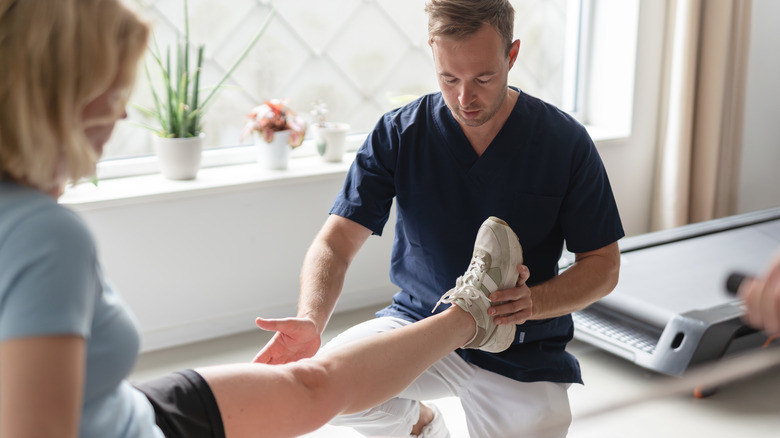If The Back Of Your Leg Is Red, It Could Be A Symptom Of This
You went out for your morning walk and noticed the back of your leg feeling crampy. When you investigate the pain, it's also red below the knee. Rather than shaking it off as an injury or cramp, consider that you might have a deep vein thrombosis (DVT). According to NHS Inform, DVT symptoms include pain, swelling, and tenderness in your calf or thigh, a heavy ache, warm skin, and redness.
DVT occurs when a blood clot gets buried within the deep veins of the muscles, typically the veins in the calf and thigh, but it can happen in other areas of the body, like the abdomen. Blood clots are jelly-like masses of blood and other cells that work to stop bleeding (per Cleveland Clinic). However, in the case of deep vein thrombosis, they develop where they shouldn't, blocking the flow of blood.
If you think a DVT might cause the redness in your leg, immediately make an appointment with your provider or head to your urgent care, especially if you have shortness of breath. It's better to be safe when it comes to your health.
Leg redness, pain are common symptoms of blood clots
Redness and pain are among the most common symptoms of DVT. It's also important to note that the redness and pain only happen to one leg. DVT doesn't typically occur in both of your legs. NHS Inform also notes that DVT pain can worsen when bending the leg.
The Centers for Disease Control and Prevention (CDC) states that certain conditions can elevate your chances of developing DVT. For example, injury to the vein or leg, like fractures or leg surgery, can make this condition more likely, You're also more likely to get a DVT if you've been sedentary for a long time. Those who have traveled by plane or car for a long time without moving and those confined to a bed should consider getting checked out, too. Specific medications with hormones (like birth control pills) and chronic conditions (like lung disease) also increase your risk. Johns Hopkins Medicine also states that those who are overweight, older than 60, or pregnant can be more prone to getting deep vein thrombosis.
Diagnosis can't be done with symptoms alone. Providers will need to take your overall symptoms into account and then complete tests like blood tests and ultrasounds for a definitive diagnosis and treatment. Typically, blood thinners are the first course of action, but you might also need surgery to clear out the clot.
Complications and preventative measures for blood clots
Blood clots aren't anything to mess with, specifically because cutting off the flow of blood causes issues within the vein. As the clot causes damage, it might lead to post-thrombotic syndrome. The American Academy of Orthopaedic Surgeons notes that post-thrombotic syndrome leads to venous hypertension and damage to the valves, which cause sufferers lasting symptoms. The continuous blood pooling at the site causes swelling, pain, and even leg sores.
The clot or clots can break off and travel to your lungs, causing a pulmonary embolism. Symptoms include coughing, dizziness, chest pain, and shortness of breath, states Penn Medicine. A pulmonary embolism needs immediate medical treatment because the cutting off of the blood flow can cause irreversible damage to the lungs and even death.
Given the complications, it's helpful to put preventative measures in place to avoid future clots. The CDC recommends moving around as soon as you can after surgery and making sure to move around every few hours when traveling. You can even exercise during a long plane ride by raising and lowering your legs. Compression stockings can also help by maintaining the flow of blood in the legs and preventing any swelling. It's also important to wear loose-fitting clothes when you travel. Avoiding a sedentary lifestyle, eating healthy, and talking to your doctor about risk factors can go a long way to keep your blood flowing.



